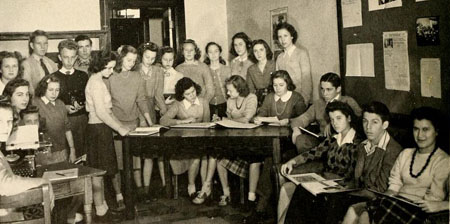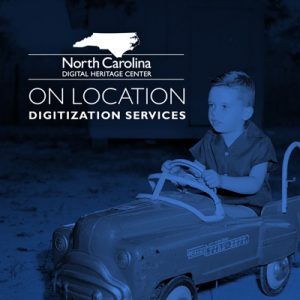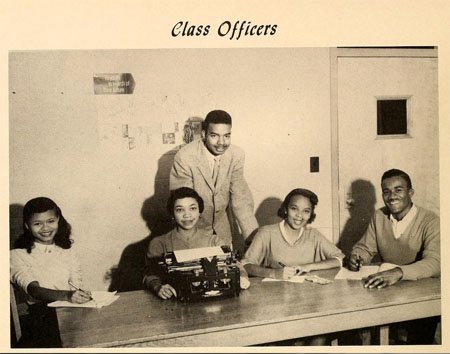
This week we have another 61 titles up on DigitalNC, including our first additions from Charleston, Culler, Red Springs, Rutherfordton, and Sanford! Included in this batch, on the front page of the February 28, 1872 issue of Raleigh’s Weekly Sentinel, is an article detailing the final heist of Robeson County folk hero Henry Berry Lowry.
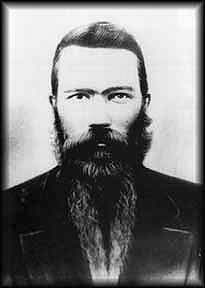
Portrait thought to be of Henry Berry Lowry. Via the State Archives of North Carolina
Henry Berry Lowry, a Lumbee Native American, was the head of the mostly Native outlaw group known as the Lowry Gang. In addition to typical outlaw activities, the Lowry Gang also helped other Native Americans avoid Confederate work conscription and fought alongside Union soldiers who had escaped Confederate prison camps. While Lowry did often resort to murder to settle personal feuds, he was also considered a sort of Robeson “Robin Hood.” When they committed robberies, they would often share the spoils with the community and would return items such as horses as soon as they were no longer needed. They were known to be “respectful” robbers and would let you off the hook if you could show you didn’t have much.
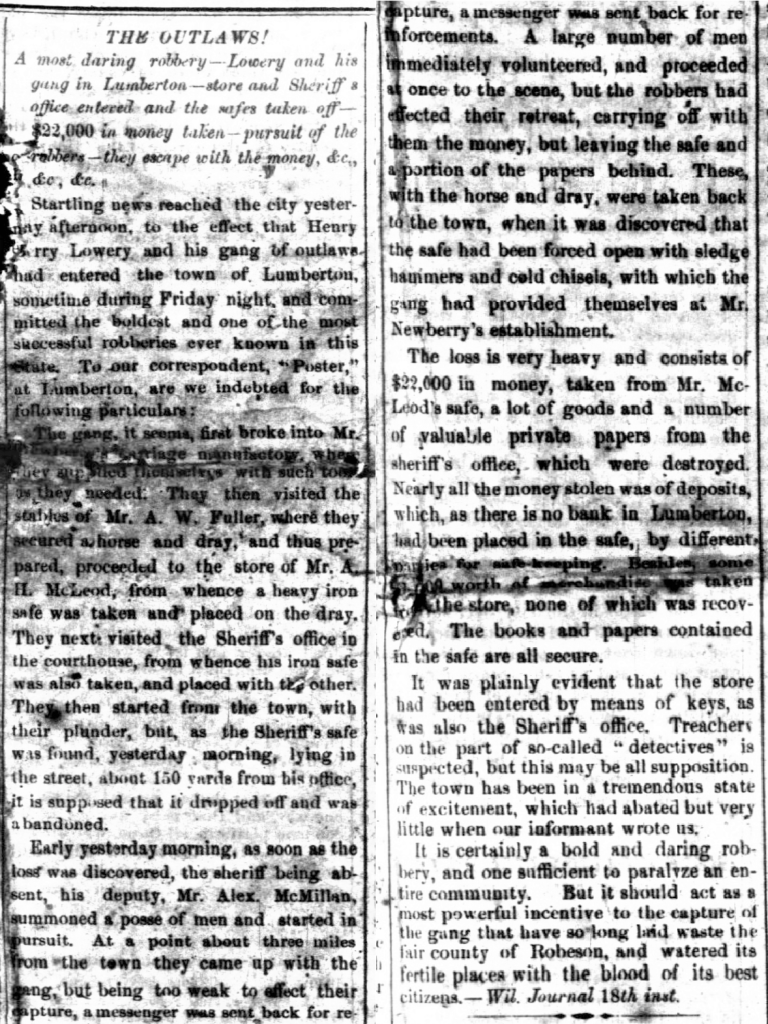
The Weekly Sentinel, February 28, 1872
In 1869, governor William Holden put a $12,000 bounty on Lowry’s head, which resulted in bloody conflict over the next few years. After successfully evading capture, Lowry planned his final heist in February of 1872. The gang stole a safe from a local carriage manufacturer and were bold enough to take another from the sheriff’s office, walking away with $22,000 (about $520,000 today) and then he disappeared. The bounty was never collected and he was never heard from again. Some locals claim they saw him at a friend’s funeral years later, but we will likely never know what happened to Henry Berry Lowry.
Over the next year, we’ll be adding millions of newspaper images to DigitalNC. These images were originally digitized a number of years ago in a partnership with Newspapers.com. That project focused on scanning microfilmed papers published before 1923 held by the North Carolina Collection in Wilson Special Collections Library. While you can currently search all of those pre-1923 issues on Newspapers.com, over the next year we will also make them available in our newspaper database as well. This will allow you to search that content alongside the 2 million pages already on our site – all completely open access and free to use.
This week’s additions include:
Asheboro
Charleston
Charlotte
Culler
Elizabeth City
Goldsboro
Greensboro
Halifax
Hertford
North Wilkesboro
Oxford
Plymouth
Raleigh
Red Springs
Reidsville
Rockingham
Rutherfordton
Salisbury
Sanford
Shelby
Tarboro
Taylorsville
Wadesboro
Warrenton
Washington
Winston-Salem
If you want to see all of the newspapers we have available on DigitalNC, you can find them here. Thanks to UNC-Chapel Hill Libraries for permission to and support for adding all of this content as well as the content to come. We also thank the North Caroliniana Society for providing funding to support staff working on this project.

This week we have another 34 titles up on DigitalNC! In this batch we have an article from the Durham Tobacco Plant describing the construction of a new factory being built by W. Duke, Sons & Co., which contained a machine that would revolutionize their tobacco business: The Bonsack machine.

Durham Tobacco Plant, July 16, 1884
In 1881, Virginia native James Bonsack created the first industrial cigarette rolling machine, a task that was done meticulously by hand up until this point. Bonsack partnered with W. Duke, Sons & Co. in 1884 and supplied them with one of his machines that could roll 250,000 cigarettes in a single day, the equivalent of 48 employees. While this acquisition would make the Dukes the leading cigarette producer in the country, the automation of the process forced many skilled rollers out of work.
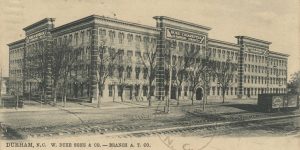
W. Duke, Sons & Co. 1884 factory. Image via opendurham.org
Over the next year, we’ll be adding millions of newspaper images to DigitalNC. These images were originally digitized a number of years ago in a partnership with Newspapers.com. That project focused on scanning microfilmed papers published before 1923 held by the North Carolina Collection in Wilson Special Collections Library. While you can currently search all of those pre-1923 issues on Newspapers.com, over the next year we will also make them available in our newspaper database as well. This will allow you to search that content alongside the 2 million pages already on our site – all completely open access and free to use.
This week’s additions include:
- The North Carolinian (Elizabeth City, N.C.) – 1869-1903
- The Yadkin Valley News (Mt. Airy, N.C.) – 1880-1895
- The Index (Wilkesboro, N.C.) – 1880-1881
- The News Reporter (Whiteville, N.C.) – 1912-1924
- The Montgomery Vidette (Troy, N.C.) – 1886-1891
- The Southern Vidette (Norwood, N.C.) – 1891-1892
- Carter’s Weekly (North Wilkesboro, N.C.) – 1920-1922
- The Alexander County Journal (Taylorsville, N.C.) – 1887-1888
- Washington Progress (Washington, N.C.) – 1892-1913
- The Chronicle (Wilkesboro, N.C.) – 1890-1911
- The Wilson Mirror (Wilson, N.C.) – 1887-1894
- Windsor Public Ledger (Windsor, N.C.) – 1887-1889
- Windsor Ledger (Windsor, N.C.) – 1889-1915
- The Daily Southerner (Tarboro, N.C.) – 1889-1922
- The Carolina Mountaineer and Waynesville Courier (Waynesville, N.C.) – 1917-1923
- Raleigh Christian Advocate (Raleigh, N.C.) – 1914
- The Elizabeth-City Star (Elizabeth City, N.C.) – 1822-1824
- The Elizabeth-City Star and North-Carolina Eastern Intelligencer (Elizabeth City, N.C.) – 1825-1833
- The North-Carolinian (Fayetteville, N.C.) – 1839-1864
- The Greensboro Patriot (Greensboro, N.C.) – 1888
- Durham Tobacco Plant (Durham, N.C.) – 1872-1885
- The Enquirer (Tarboro, N.C.) – 1871-1873
- The Times (Greensboro, N.C.) – 1856-1861
- Halifax Compiler (Halifax, N.C.) – 1818
- Halifax Minerva (Halifax, N.C.) – 1829-1830
- The Edenton Gazette, and North-Carolina Advertiser (Edenton, N.C.) – 1806-1809
- The Edenton Gazette (Edenton, N.C.) – 1809-1813
- The Edenton Gazette, and North-Carolina General Advertiser (Edenton, N.C.) – 1814-1822
- Edenton Gazette (Edenton, N.C.) – 1827-1831
- The N.C. Republican, and Civil Rights Advocate (Weldon, N.C.) – 1884
- The Weldon Patriot (Weldon, N.C.) – 1852-1859
- Railroad Ticket (Weldon, N.C.) – 1881
- The Semi-Weekly State (Weldon, N.C.) – 1867
- Webster’s Weekly (Reidsville, N.C.) – 1881-1916
If you want to see all of the newspapers we have available on DigitalNC, you can find them here. Thanks to UNC-Chapel Hill Libraries for permission to and support for adding all of this content as well as the content to come. We also thank the North Caroliniana Society for providing funding to support staff working on this project.
If you’re a big fan of Lin-Manuel Miranda’s hit musical Hamilton (based on the life of Alexander Hamilton), you may remember the song that Aaron Burr sings about his daughter, “Dear Theodosia.” But what you may not know is that Theodosia Burr’s story comes to a head (that joke will make sense in a minute) in North Carolina.
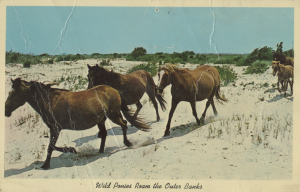
Theodosia Burr was primarily raised by her father and received the kind of education that was typically reserved for the men of her time. She had a strong relationship with her father and admired him greatly, according to her letters. Among the country’s early framers, Aaron Burr was one of the few early defenders of women’s rights (7:18) (due partially to the influence of Theodosia Prevost, Theodosia Burr’s mother).
Aaron Burr’s dedication to Theodosia’s education helped her become one of the most distinguished women in early American society—and one of the most sought-after. She was apparently pursued by the artist John Vanderlyn and the writer Washington Irving. Vanderlyn allegedly painted Theodosia’s eye as a “memento of his love” (10:32) and wore it on his lapel. The most appealing suitor, though, was Joseph Alston, who would go on to become governor of South Carolina. They were married in February 1801 in Albany, New York (11:34). In 1802, Theodosia gave birth to a son, Aaron Burr Alston (15:09).
In 1807, Aaron Burr was tried and acquitted of treason, leaving his political reputation in a sorry state. To escape the negative attention, he went into self-imposed exile in England, where he stayed for four years. The separation was apparently hard on Theodosia, who didn’t see her father during that period. Then, in 1812, her son died of malaria at the age of 10 (19:50), leaving her even weaker and and more depressed.
When Aaron Burr finally returned to New York in June of 1812, Theodosia was desperate to reunite. However, her poor health made her family worry about travel on land, and the ongoing war meant that most ships had been seized by the Navy to fight the British (20:14). Finally, in the fall of 1812, Alston secured a small pilot boat, The Patriot, to take Theodosia up the East Coast from Charleston to New York. As Oscar Stradley explains (5:26), the boat was designed to sail close to the shore and arrive in New York in 5 to 6 days. Theodosia and the crew of The Patriot left Charleston on December 30, 1812.
A quick sidebar is necessary here to explain what happened next—and it involves our old friend Hamilton. As many North Carolinians know, the Outer Banks has a long history as a treacherous area for sailors, especially on dark nights, when the coastline is hard to see (not to mention the threat of pirates, which we’ll get to in a minute). Alexander Hamilton, who was personally familiar with the “graveyard of the Atlantic,” used his influence within the Washington and Adams administrations to get funding for lighthouses (1:50). He was successful in securing funding for one famous gal in 1794: Cape Hatteras.
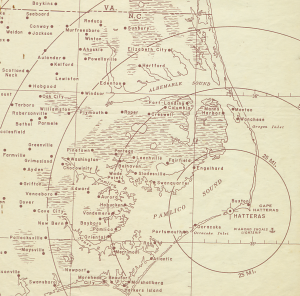 Although Cape Hatteras provided some light for ships around Hatteras and Ocracoke by the time it was lit in 1803, by 1812, there still wasn’t good lighting around Nags Head, which is to the north (close to Kitty Hawk and Kill Devil Hills). This set up the perfect opportunity for land pirates in the area.
Although Cape Hatteras provided some light for ships around Hatteras and Ocracoke by the time it was lit in 1803, by 1812, there still wasn’t good lighting around Nags Head, which is to the north (close to Kitty Hawk and Kill Devil Hills). This set up the perfect opportunity for land pirates in the area.
On dark nights (which are especially common in the fall and winter in the Outer Banks), pirates would lure ships aground with a sneaky trick: they would tie a lantern to the neck of the ponies commonly found on the islands and lead them up and down the hills (6:48). From the perspective of boats on the water, this looked a lot like the light on another ship bobbing nearby (a “nag” is a name for an old horse).
Although the details of what happened to Theodosia and the crew of The Patriot are still a bit of a mystery, accounts of pirates that surfaced in the 1830s led people to believe that the boat was taken in by this trick at Nags Head. Stradley notes that the crew may have been trying to determine their location when they accidentally ran ashore and fell victim to pirate murder (8:20).
The reason that we think Theodosia made it to the Outer Banks comes down to one enticingly-vague clue: a portrait that is probably of Theodosia. In Stradley’s telling, Theodosia escaped the initial pirate attack with the portrait of herself, which she intended to give to her father when she arrived in New York. The pirates may have left her on the beach, he posits, because of superstition surrounding people with mental illness, or people “whose minds had been taken by God” (10:59).
The portrait was rediscovered by Dr. William Poole, a physician from Elizabeth City who made a house call to a small fishing cabin on Nags Head in 1869 (12:06). Apparently, the owner of the cabin gave the portrait as payment for medical treatment. The portrait has a strong resemblance to Theodosia’s earlier portraits, and when it was discovered, some of her surviving family members confirmed the likeness (39:10).
Stradley tells this part of the story as if Dr. Poole was called to treat Theodosia herself (who, in 1869, would have been in her late eighties). Before Dr. Poole could take the portrait, however, Theodosia allegedly grabbed it off the wall, ran out of the cabin, and disappeared into the night (she was a sprightly eighty-six) (12:55). The portrait was later found washed up on the beach, and Theodosia was assumed to have drowned.
Another version, explained by Marjorie Berry, historian for Pasquotank County, says that Dr. Poole was called into the cabin of Mrs. Polly Mann, a fisherman’s widow (27:30). The portrait stood out in the otherwise plain cabin, so Dr. Poole asked where it came from. Mrs. Mann explained that her old beau, Joseph Tillet, had been one of the ship’s wreckers, and that he had gifted her two black dresses and the portrait, which he had taken as his share of the loot. (In this version, the wreckers had found the ship already empty when they arrived.)
In contrast, the report that Aaron Burr received, according to Berry, was that Theodosia was drowned by a storm. Since British ships were waiting off the coast of North Carolina (they were, after all, in a war), one admiral sent Burr a message describing a rough storm that hit the Outer Banks on January 2, 1812—around the time that The Patriot would have been there (29:44). The fact that there was a huge storm in the area is a detail missing from all the pirate confessions that came forward, leaving some doubt as to their veracity.
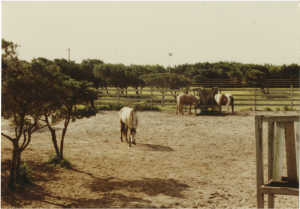
Horses on Ocracoke Island
Whatever happened to Theodosia Burr, the story of her life and disappearance has been told and retold in Northeastern North Carolina many times; a copy of her portrait is on display in the Our Story Exhibit at the Museum of the Albemarle. You can hear the Oscar Stradley’s full version of the story here (courtesy of Mitchell Community College) and Marjorie Berry’s version in the recording of “History and Highballs: Theodosia Burr” from the North Carolina Museum of History.
Have you been interested in working with the Digital Heritage Center but find it difficult to get to Chapel Hill, or have concerns about having your materials off site? We want to come to you! We’ll be working with two or three cultural heritage institutions over the next nine months to try out on-location scanning. If you’d like to nominate your institution, read on and use the nomination form linked at the end of this post.
What We Do
Here’s what nominated institutions will receive as part of this process.
- We will bring our scanners, computers, and staff to your institution to digitize and describe materials from your collections. We would be there for one full weekday, at a minimum.
- We’ll host the scanned images and associated metadata on DigitalNC.org, and give you copies of the original scans to use in any non-profit context.
- Optionally, we can do a presentation for staff and/or the public related to any of the following topics:
- The Digital Heritage Center’s services (for staff at your institution and/or other local cultural heritage institutions)
- A demonstration of what we’re doing while we’re there (for staff at your institution)
- The variety of resources you can find on DigitalNC.org and other fantastic digital collections in North Carolina (staff or the public)
What We’ll Need from Partners We Visit
If you’re chosen, we’d need:
- At least one conference call before arrival to clarify expectations, work with you on scheduling, and talk through the materials you’d like scanned.
- Description and a light inventory of the items we’ll be scanning, if there isn’t one already available.
- Some assembly and preparation of the materials you’ve chosen. This might include physically pulling all of the content together before we arrive and removing staples if the materials are stapled at the top corners.
- A designated staff contact regularly available to ask questions regarding what we’re scanning while we’re there, and to help with logistics like getting equipment in and out of the building, etc.
- An indoor location that has:
- at least two power outlets,
- internet connectivity,
- a work area large enough for 2 scanners and 4 laptops as well as extra room for materials handling,
- seating for four people, and
- is away from the public so we can get the most scanning accomplished in our limited time (ideal but not required).
Additional Guidance for Nominations
- We’ll be giving priority to nominations from institutions furthest from Chapel Hill and to new partners. If you are a prospective partner, please check to make sure you’re eligible.
- The materials have to be owned by your institution.
- The materials should cover North Carolina subjects, events, and people.
- For these on-location sessions, we’re accepting nominations for the following types of items:
- photographs (prints) and/or postcards
- looseleaf print materials up to 11×17”
- bound items may be considered, but in very limited numbers and only if transporting them to Chapel Hill would be impossible
- Materials can be fragile but should be stable enough to withstand gentle handling and placement on a flatbed scanner.
We’ll review nominations according to the following criteria, so you may want to address these in your nomination form:
| Category |
Point Value |
| New partner |
1 |
| New town |
1 |
| New county** |
2 |
Materials document an underrepresented
community or population |
1 |
| Materials are well described/inventoried |
5 |
| Majority of materials date from 1945 or earlier |
1 |
| Materials are believed to be unique |
1 |
** We have yet to work with any institutions in the following counties: Alexander, Bertie, Bladen, Camden, Caswell, Chowan, Clay, Currituck, Dare, Gates, Graham, Greene, Henderson, Hoke, Jones, Mitchell, Northampton, Onslow, Pamlico, Swain, Tyrrell, Yancey
Use this nomination form to submit!
We’ll start reviewing nominations on September 30 and will notify selected institutions shortly thereafter. If a selected institution ends up not being able to host us, we’ll continue down the list.
We’re excited about trying out this new service. Please contact us with any questions and share this with any institutions you think might be interested.
